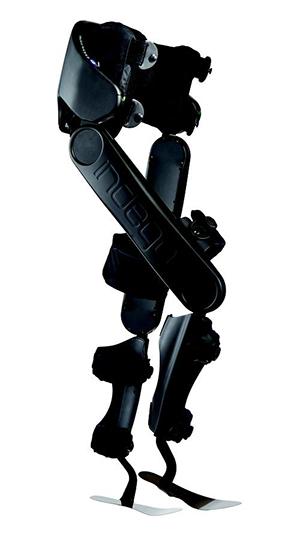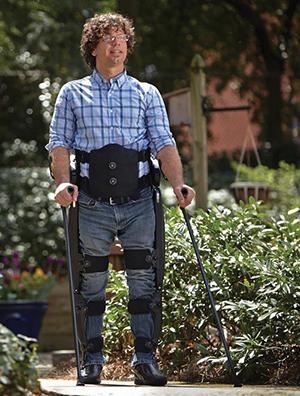Study to Demonstrate Benefits of Exoskeleton for Spinal Cord Injuries
Engineers are hoping that a four-year government study will demonstrate the benefits of an exoskeleton that could one day help thousands of people with spinal cord injuries.
January 17, 2016
Engineers at Parker Hannifin Corp. are hoping that a four-year government study will demonstrate the benefits of an exoskeleton that could one day help thousands of people with spinal cord injuries.
The study, conducted by the US Department of Defense and the Congressionally Directed Medical Research Programs, will examine the viability of the company’s sophisticated Indego exoskeleton, which uses electric motors, sensors, and software to enable paraplegics and stroke victims to stand and walk. It could help demonstrate not only that devices like Indego can be used by people with spinal cord injuries, but that such devices can be economically feasible, as well.

Indego works in a manner similar to that of a Segway personal transportation device. Accelerometers and gyroscopes provide position and angular velocity data, while brushless DC motors provide motion in response to the data. The exoskeleton can support up to 250 lb.
(Source: Parker Hannifin Corp.)
”One challenge for devices like this one is that they can be prohibitively expensive,” Aidan Gormley, director of communications and branding for Parker Hannifin, told Design News. “The DoD study will help prove out the economic benefits.”
If the technology is deemed beneficial, it could be a big step forward for more than 270,000 individuals in the US who have spinal cord injuries. Indegeo would enable those individuals, not only to walk and stand, but to get in and out of chairs while wearing the device.
Designers of the device describe it as a wearable robot. “It’s the same technology that goes into a Segway,” notes Ryan Farris, engineering manager for Parker Hannifin’s Human Motion and Control business unit. “On a Segway, you lean forward and it rolls you forward. In our case, you lean forward and it walks you forward.”

The mobility benefits of Parker Hannifin’s Indego exoskeleton on 54 individuals with spinal cord injuries will be studied over the next four years.
(Source: Parker Hannifin Corp.)
Indego accomplishes that by employing three-axis accelerometers, gyroscopes, and brushless DC motors on a modular, lower-limb orthotic brace. By “knowing” the user’s posture -- his or her tilt, orientation, and joint angles -– the device is able respond appropriately to virtually any situation. When a user leans forward, for example, Indego responds by moving their foot forward. Leaning backward, meanwhile, serves as a cue that the user wants to sit down. Indego responds by using the motors to help the user descend in a controlled way.
To recognize the user’s actions, the device employs a software algorithm that fuses the orientation data from the accelerometers to the angular velocity data from the gyroscopes. Using the fused data, the system’s microcontroller then commands the hip and knee motors to produce the motion. Power for the motors comes from an onboard lithium-ion battery.
"There’s no buttons to press,” Farris told us. “It’s all very intuitive, based on the posture of the user.”
[Visit Parker Hannifin at Booth 2801 at Pacific Design & Manufacturing, Feb. 9-11, at the Anaheim Convention Center.]
Designers of the system also endowed it with “back-driveability,” which enables patients to contribute to the motion if they are able. That way, stroke victims and others who have some limited use of their muscles may work cooperatively with the device to help build their strength during rehabilitation
"We tried to create a system that will work for everybody,” Farris said. “It helps them walk. It’s not a machine where they get in and go for a ride.”
In the past, engineers around the world have labored somewhat unsuccessfully to create similar mobility devices using everything from hydraulic motors to internal combustion engines for power, but Parker Hannifin engineers believe this device offers three key advantages over those predecessors. Indego, they say, offers light weight (26 lb), a narrow frame so it can be worn in a wheelchair, and modularity, so it can be easily transported.
READ MORE ARTICLES ON EXOSKELETONS:
"It needs those qualities if it’s ever going to leave the lab and be used at home,” Farris said.
The government study will examine the device’s mobility benefits and look at its influence on neurological recovery. It will also investigate its practicality in home/community settings. A total of 54 test subjects will be enrolled in the study over the next four years.
Parker Hannifin is currently awaiting FDA approval for the device. The company’s engineers hope it will eventually reach the market for patients with full- and partial-spinal cord injuries, as well as patients who are trying to reconnect neural pathways after suffering strokes.
“Our goal is to make it as broadly accessible as possible,” Farris said.
Senior technical editor Chuck Murray has been writing about technology for 31 years. He joined Design News in 1987, and has covered electronics, automation, fluid power, and autos.
Like reading Design News? Then have our content delivered to your inbox every day by registering with DesignNews.com and signing up for Design News Daily plus our other e-newsletters. Register here!
About the Author(s)
You May Also Like

.jpg?width=300&auto=webp&quality=80&disable=upscale)

